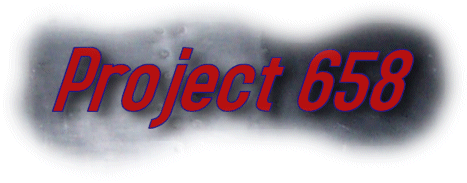Now owned by MAPS Air Museum on the west side of Akron-Canton Airport
in Green, Ohio, F-86L s/n 53-658 is just starting on the road to static
display standard.
Click here for details of
the service history and recovery of 53-658.
October
2010 Update
There's just
no stopping those folks at MAPS: see below for further significant milestones.
This really will be one fine-looking airplane when it's finished. In
fact I have to say it looks pretty fine already!
The two major
items to report this month are that the rocket tray has been completed
by Dan Willamen and has been installed too. This really will make '658
look the part and it's an item that's missing from many restored F-86D/Ls.
Since the rocket pod was often in the 'down' position on the ground,
it's also a realistic way to pose the aircraft. Any chance of a small
production run to help out other museums fellas?
The second area that's received welcome attention is the speed brake
areas. These have been stripped and repainted and look so much better
for it. MAPS' intention is to display the aircraft with flaps, slats
doors and speed brakes open, so this was a vital part of achieving that.
It will also make '658 a lot more interesting to look at.
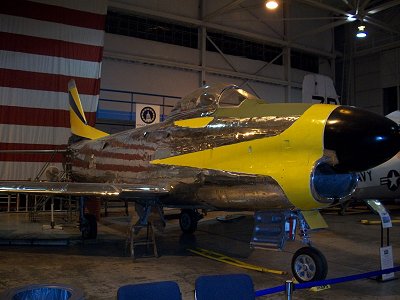 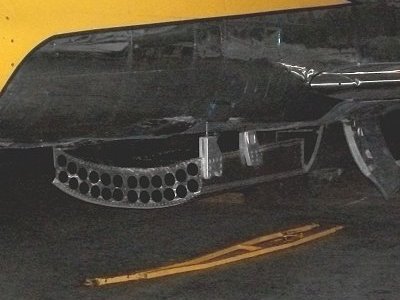
Above
left: Polishing and painting of the RH side continues and (right) -
the completed rocket pod installed on '658. Below left: The LH speed
brake area before restoration and (right) after. (Kent Kleinknecht).
September
2010 Update
This update
will serve to cover the multiple achievements of MAPS regarding 53-658
over the last few months. Progress has been tremendous and any indications
otherwise are purely because of my inability to update the website (apologies
Kent!).
July 2010:
The team has been
busy with events in the hangar, so restoration has come to a standstill.
However small sheet metal projects have been moving forward:
1) Access panels for the underside of the wing have been made as well
as the beginnings of the rocket tray.
2) Main gear doors have been repaired, painted and polished.
3) Nose gear actuator reattached along with access panels
4) Work to lower the starboard flap has begun. Hopes are to display
the plane with both flaps down in typical pre-flight mode.
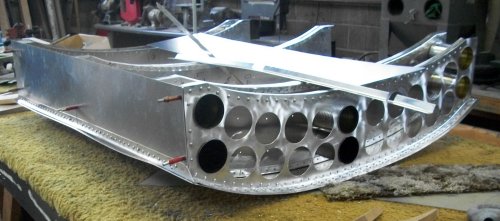 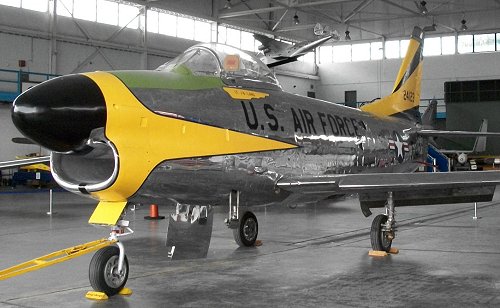
Above left:
Another task that has been started - creation from scratch of the
rocket tray. This item was missing when '658 was originally recovered
by MAPS. Above right: 53-658 as she appeared in July 2010 (Kent Kleinknecht).
June 2010:
A major piece of
news is that Harry Rose (former F-86D crew chief and member of the 496th
FIS and new MAPS member) has gotn the museum a complete cockpit section
of a Sabredog. This will make a fantastic display for the museum and
is pretty much 100% complete in terms of instruments. The cockpit is
down in Texas and will need funds to recover it.
Restoration-wise
these items were tackled during the month:
1) Main gear doors removed for repair. It appears that the main gear
struts lost pressure and the doors dug into the earth.
2) Port side flap installed and polished.
3) New Oleo clamp on nose strut, Canopy and new wind screen installed.
Work will continue
on the starboard side, polishing during nice weather and then switching
to sheet metal as the weather turns cold again.
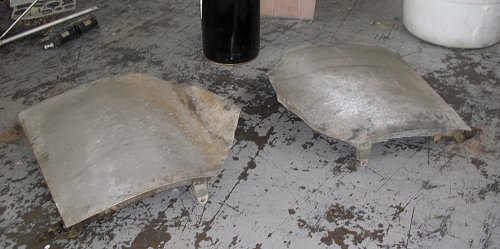
Above: Main
gear doors as-removed. They'll be restored with new skins. Below left:
The right side of the aircraft will be next to receive attention and
(below right): the new flap skin on the LH side gleaming after a polish.
(Kent Kleinknecht).
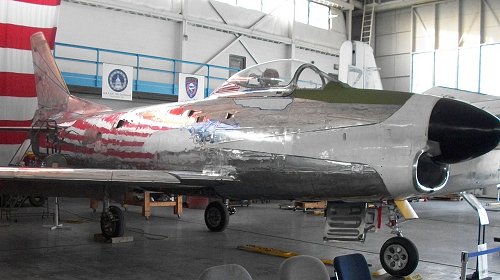 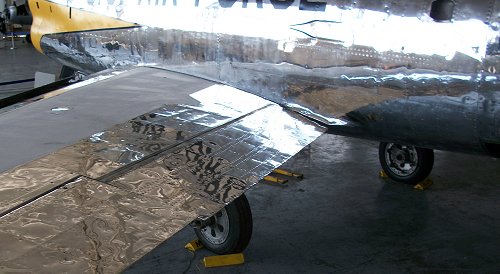
May 2010:
With Spring arriving
and much warmer temperatures, the team was able to ramp-up again on
the project. Most of the major markings were done on the port side,
and will be progressing onto the small stencils over the summer. A number
of other items were also done, including:
1) Front wind screen, plexi has been rough fitted. new frame is being
fabricated for the front glass.
2) Wing patch, port side. The large patch was being riveted today. Access
door will come this week.
3) Starboard Flap. Frank has got most of the rivets in , will need trailing
edge made to finish the project.
4) Port Flap. New top skin has been installed. Bottom patch skin was
dimpled and will be riveted next week.
5) Main gear doors where removed, repairs will take place in the coming
months.
6) New oleo clamp for front nose gear. Will be fabbed and installed
in coming weeks.
7) Several small repairs on both wings have been made to repair punctures.
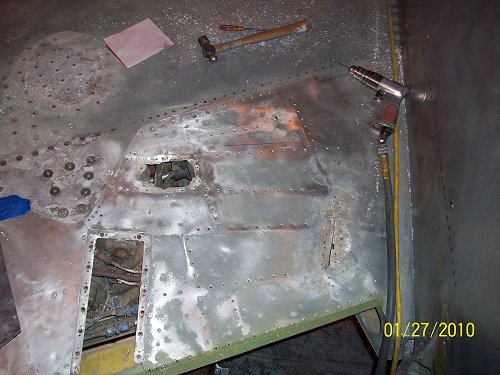
Above: This
area of damaged skin near to the LH wing root (it's above the main
landing gear trunnion) had borne a lot of damage. The MAPS team decided
to repair by replacement. Below: The skin removed at left and (right)
the new skin awaiting rivetting. (Kent Kleinknecht).
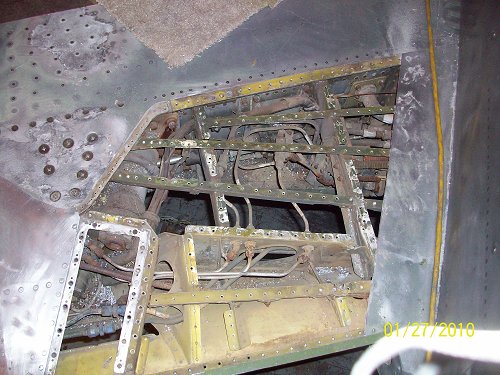 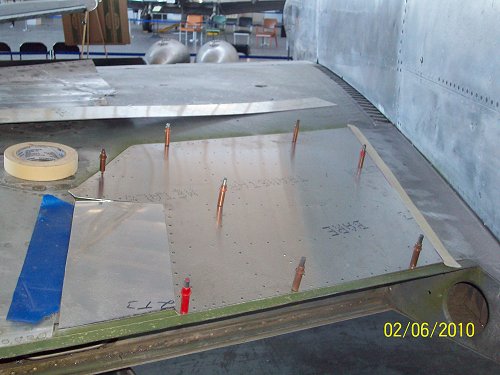
Below: The
stencils for the main markings being applied. The bright yellow of
the 496th FIS nose flash has already been applied. (Kent Kleinknecht).
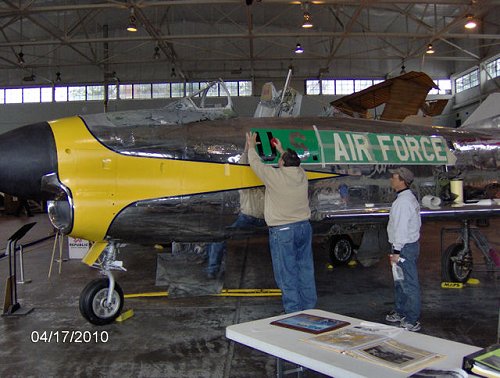
April 2010:
The project continues
to move forward. Work moved under plastic in order to try and keep the
dust off the rest of the aircraft in the hanger. The goal for the is
to get one side of the plane looking sharp for the summer events season.
Kevin McDonald's skill in painting and detail work are really showing
as the team have reached a point where the 496th FIS colours could start
to be put on the plane. Thanks to Dave, Jerry and Frank for their continued
efforts in fixing the flaps: hopefully those projects will be done in
the coming month.
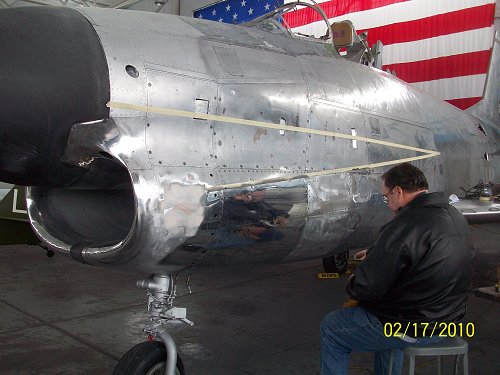
Above: Polishing
work in progress on the forward fuselage. The 496th FIS scallop has
also been roughly masked on the nose to indicate what needs polishing!
March 2010:
Kevin and Kent
have been working diligently on the skin, enabling the left side to
be almost ready for graphics. The right wing flap is still being worked
on as well as progress on the repair patch on the left flap.
February
2010 Update
Since the
last update a number of key milestones have been achieved, including:
1. New tires
and inner tubes installed.
2. Fuselage wet-sanded prior to polishing.
3. First coat of rubbing compound applied to fuselage.
4. Final polishing of fuselage started, prior to painting.
5. Detail sheet metal work - mainly filling pop rivet holes with flush
rivets.
6. Reattachment of any missing or loose fasteners.
7. Main nose wheel door reskinned.
8. Work finished on fwd nose gear door.
9. New skin rivetted on port-side flap
10. Start of paint removal from starboard wing.
11. Fuselage/flap fairings manufactured.
During the
Christmas holiday, Kent Kleinknecht was able to get the entire surface
of both wings cleaned of paint. Main focus is now on the remaining areas
of sheet metal repairs and a start has been made on laying out the paint
scheme on the fuselage. Kent's son was able to lend a hand and cleaned
both landing gear struts and doors.
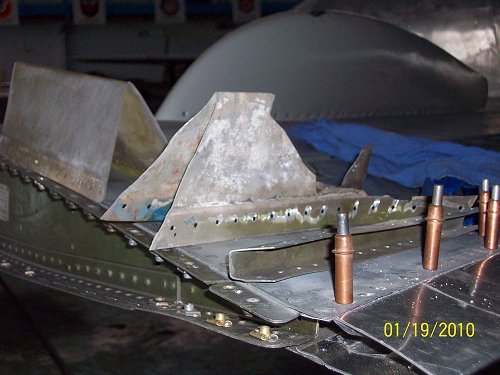
Above: This
close-up view shows the replacement nut plates inside the wingtip
(which in turn will hold the wingtip fairing attachment screws) and
the work in progress on replacing wingtip extension trailing edges.
Resting on top of the wing is the original damaged section (at right)
and a further section which had been pop-rivetted over the damage
at some point in the past at left. Below: Dave and Jerry working on
the new port-side flap skin. Fortunately the right-hand flap will
not need a complete re-skin. (Kent Kleinknecht).
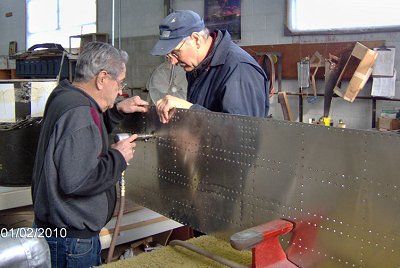
During January
and despite a cold hangar, the restoration crew pressed on. New member
Kevin McDonald (polishing specialist) has committed to help MAPS get
the best possible shine on the plane. Kent Kleinknecht spent the month
tackling small sheet metal jobs, including:
1. Re-making the
trailing edges of both wing extensions (added when the plane was upgraded
to an "L" from a "D").
2) Repaired/replaced more than 100 nutplates on the wing tips.
3) Began cleaning up the trailing edges of all the wings. Most of these
are still in place but they are corroded and with rough edges.
MAPS is pleased
to announce that the Miller Foundation has awarded the musuem a further
$1,000 to help with the restoration. The team will use this valuable
donation to track down missing parts or use it to help in the cost of
fabricating replacements.
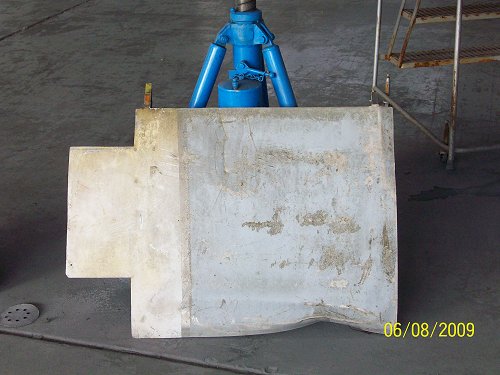
Above: Before.
Below: Work in progress at left and (right) the finished item. (Kent
Kleinknecht).
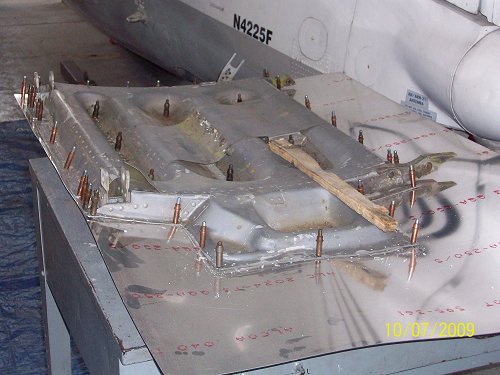 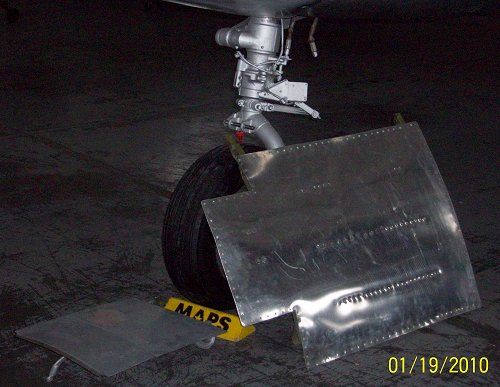
June
2009 Update
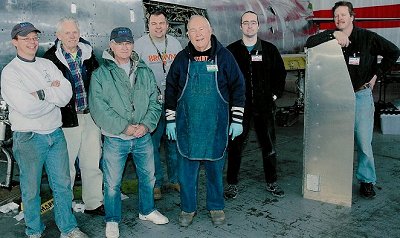
Most
of the MAPS F-86L restoration team are present in the photo above (L-R):
Kent Kleinknecht, Frank Wrenick, Paul Gates, Ken Koehn, Carl Koehn,
Andy Bear, Ray Scherry. Not pictured here are Dave Sanders and Jim Mosley.
(Ken Koehn).
Recent work has
focussed on a rarely-seen area - the engine intake. There's a lot of
metal to rub the corrosion out of and space is restricted. Luckily Ken
Koen had a plan......
"My wife, being only 5 foot tall, is a natural for the intake. My son
Michael worked his way into the access holes in the main wheel well
and was able to sweep out a great amount of accumulated filth from the
fuselage bottom. Good having small helpers sometimes. Controlling the
corrosion is number one on that agenda, followed by some paint in the
intake to keep corrosion at bay (No way I can keep the intake natural
metal based on the corrosion and pitting, but I figure an aluminum paint
in the intake will not look so bad."
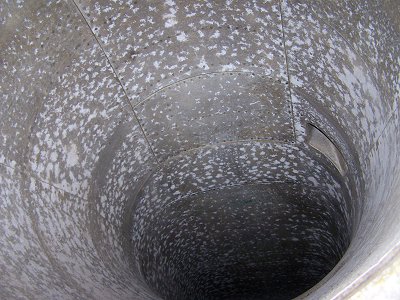 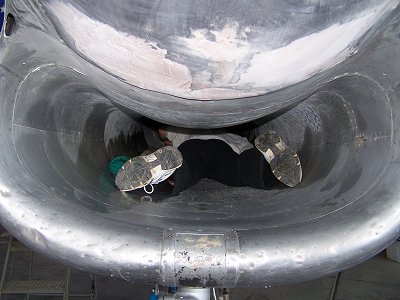
Above
left photo gives a good idea of the surface corrosion present in 53-658's
intake. At right is Ken's wife hard at work (Ken Koehn).
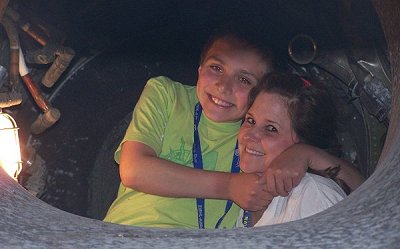
The
Intake Team - Ken's son Michael and wife Tanya suitably framed by the
interior and rear intake section of 53-658. (Ken Koehn).
On 5th May Ken
put the first coat of paint on the radome: "I have it all symetrical
now, and just need to smooth out a few areas and fill some pinholes.
In a couple of areas on the radome I sanded so much you can see light
through the fiberglass, so for better or worse, this is going to be
the final product - I cannot sand or shape any more." By 11 May Ken
had done some more work, "I am very happy to say I have all the shaping
done, (as much as the thickness of fiberglass would allow for) and I
did some more filling and sanding after this primer coat to fix some
small flaws. One more heavy coat of primer, then the gloss black final
coat. I will probably coat it with some wax to help seal the finish.
It actually looks like a F-86D radome. Considering what we had to start
with, I think everybody will be pretty pleased with the final result."
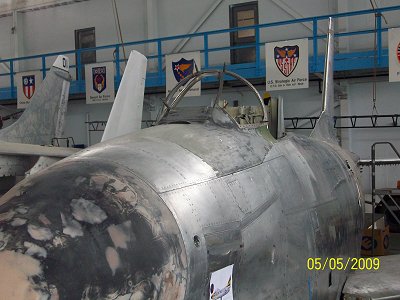 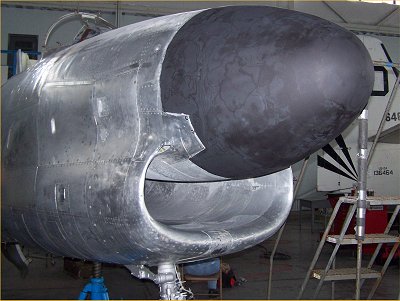
Above:
progress on the radome showing the various filled areas at left and
(right) the first light coat of primer. (Ken Koehn)
Throughout May
work continued on external and internal sanding of the airframe to get
a uniform finish to the natural metal. The Intake Team (Tanya and Michael)
were able to remove the cover plate at the rear of the intake, allowing
access to the corrosion from both sides, "We will be power sanding this
corrosion off, then will give the entire intake a coat of metallic paint/corrosion
inhibitor to finish it", says Ken. Initially it had been proposed to
put a plug in the intake front, but again Ken's dogged determination
to do a good job deserves much credit. As Ken says, "....we have to
arrest that corrosion, and the Dog looks much better with the intake
open. A lot more work is then planned, but it needs to be done right."
Externally, sanding
continues on the fuselage, (this laborious work done by Ken and Carl
Koehn) starting with 60-grade and progressing through 100, 220, 400
and 600. Once the skin is wet sanded with 800-grade, you can see your
face in the reflection from the bare metal. However to give a realistic
in-service finish the team are going to try stopping at 1000 grit and
see if the polishing tools will take them the rest of the way.
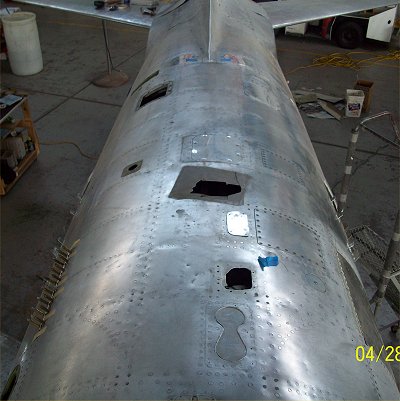 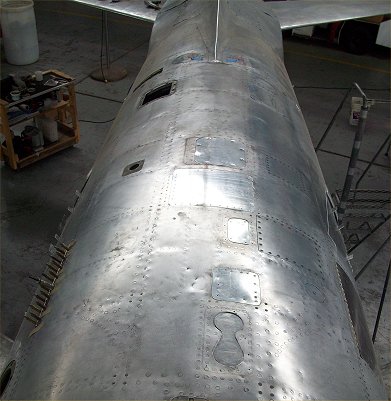
Above: 'Before'
and 'After' shots showing further progress on the repair of numerous
holes in the airframe. (Ken Koehn)
On 28th May Ken
Koehn made a major breakthrough: "I purchased some rotary palm sanders,
and have been using dry 60 grit sandpaper to grind out many imperfections
and grafitti. After getting the surface uniform, I then use the same
tool with 220 grit to smooth things out. Amazing how well this works.
I had been afraid 60 grit would be way too rough for a natural metal
finish, but the rotary sander smoothes things out very well, then the
220 really smoothes it out. Looks like we will stop with a wet sanding
of 800 in preparation for polishing. This is huge, as the amount of
time savings is incredible, plus using 60 grit I can eliminate many
of the imperfections and deep engravings. Cool!"
To prepare the
anti-dazzle area on the upper nose section, the windscreen frame has
been refitted. This will help to identify any problems that need repaired
before painting. The aircraft markings have also been temporarily placed
on the fuselage to show areas that will not need to be polished so highly.
Dave Sanders has
begun the process of fabricating a new wing slat section (left wing)
and this is moving along nicely. Access panels are still being made
and the team hoped to have them all be done by the end of May. Finally
the team welcomed Jim Mosley to the active crew. Jim has been a longtime
member at MAPS with loads of experience and will be working on 53-658's
wingtips.
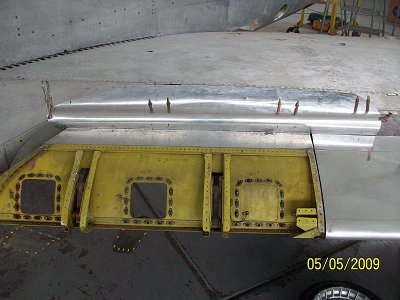 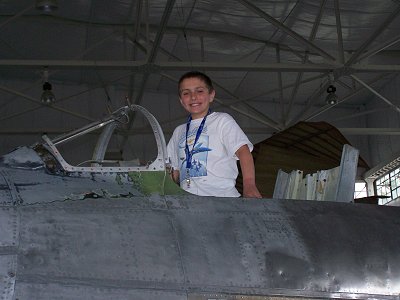
At left above
is the new inner slat skin awaiting fitting (shown just to the rear
of the slat structure) and at right a further view of the dry-fit
windshield frame with 'hangar pilot Michael Koehn (Ken Koehn).
April
2009 Update
The
MAPS team are now working on some new leading edge slats, and additional
sheet metal work is being done. Progress is also being made on the sanding
and blending of fuselage panels. The many dents in the skin of the aircraft
are gradually disappearing and though slow, this essential work is gradually
transforming the appearance of 53-658. Ken Koehn has now taken over
the final finish of the radome, and considering how beat up it was to
begin with, Ken thinks he will be able to get a good rendition out of
it.?
Another key piece
of the jigsaw - the front nose gear door (previously donated by Walter
Soplata) has now been repaired and awaits installation.?
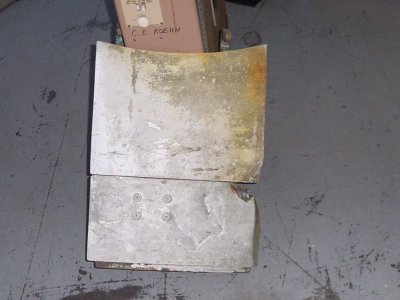 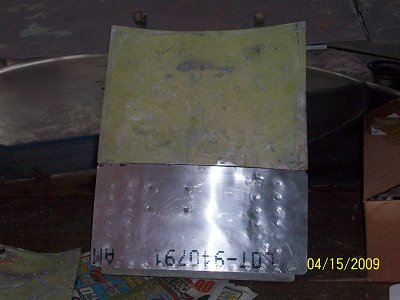
Above
left - 'before' shot of the nose landing gear door and (right) a shot
of the repair done to the lower part (Ken Koehn).
Not all the work
is structural however: the team is doing well with the aircraft's undercarriage,
and the restoration has benefitted from the donation of mainwheel tyres
from Goodyear. The mainwheels themselves have now been dismantled for
restoration. Below are a couple of shots showing progress on the nose
gear.
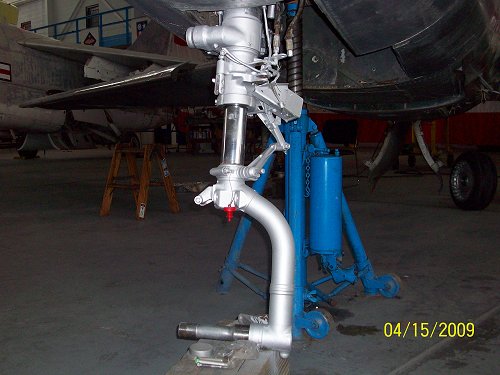 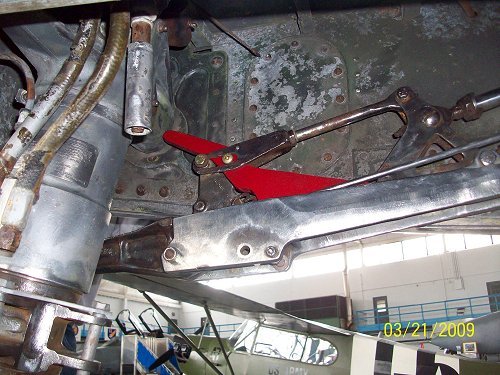
Progress
on the nose gear: at left the repainted nose leg and at right the new
(red-painted) nose lock installed. The latter prevents the undercarriage
from folding (Ken Koehn)
One large hole
has also now been filled: following the installation of a new external
skin, the port-side electrical bay access panel has been reinstalled.
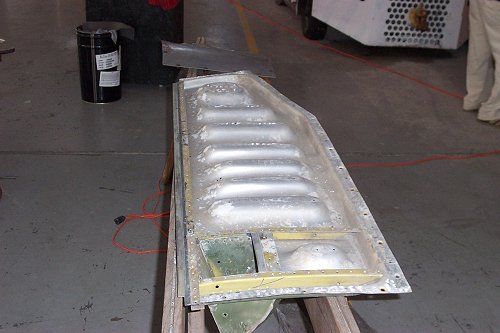 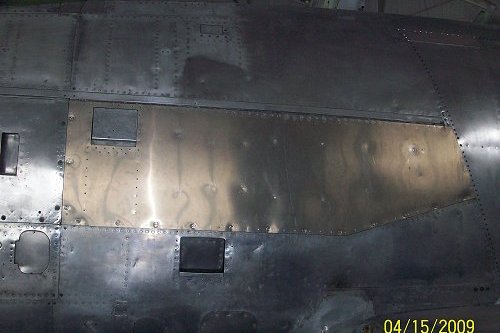
At
left above is the internal surface of the starboard panel (shown to
display the method of construction). At right the port-side panel re-skinned
and installed on the aircraft (Ken Koehn).
I shall end this
instalment with a recent view of '658:
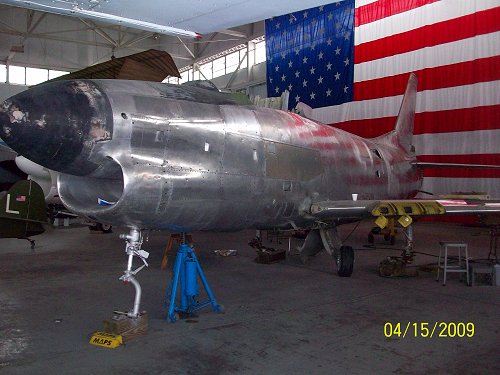
February
2009 Update
During February
the museum received a major boost for the project: a $1,000 donation
for the restoration of '658 from MAPS member and F-100 crew chief Ken
Ramsay. This generous gift has allowed the team to purchase all the
fasteners required to finish the restoration. It will also enable new
inner tubes to be purchased so that refurbishment of the nose wheel
and mainwheels can begin. The donation was a major validation of the
considerable work that the MAPS team has done on 53-658, especially
regarding the quality of the work done.
One example
of the excellent work being accomplished is in the tail section of the
aircraft. Previously the team had welded up the torque tube for the
all-flying tail (it had been cut at some point in the past), thereby
making this item whole again. Once this had been completed, the time-consuming
task of renovating and replacing panels in this area could begin, and
the recent results can be seen below.
Above
- Work continues on the tail section - Jan 09 at left, Feb 09 at right
(Ken Koehn).
Just about the
only panel to be fitted now is the main fillet panel, and work on the
starboard fairing has begun, using its opposite number as a pattern:
Moving forward
along the fuselage, further replacement panels are gradually being made,
and once installed, they improve the appearance of the aircraft greatly.
Below are a few 'before-during-after' shots of the port-side engine
access door being made and fitted, plus in the bottom photo, the new
fuel probe access door (held on by 54 screws) can be seen installed
at the left.
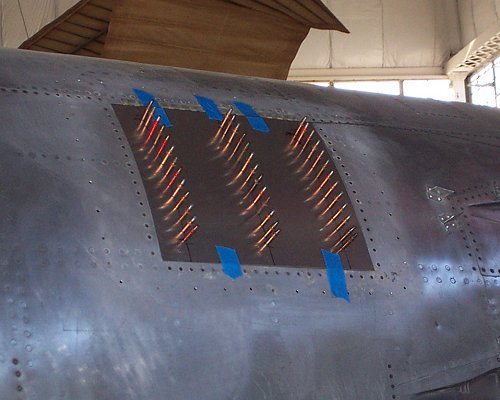 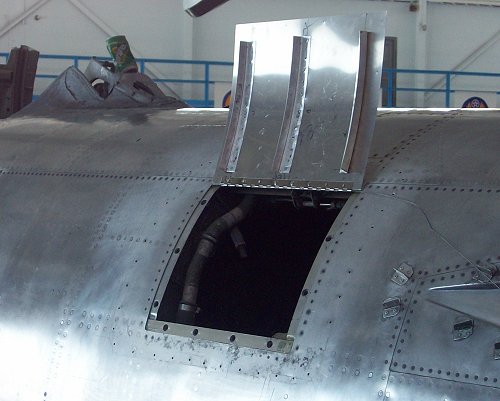
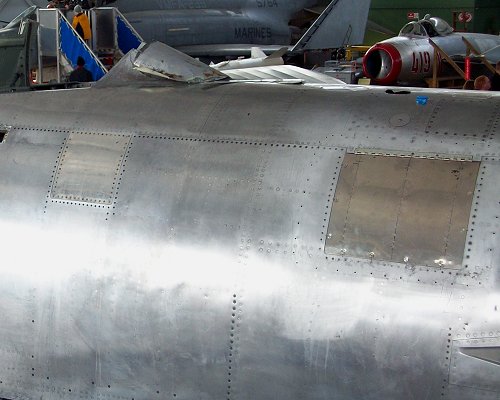
January
2009 Update
One major
news item is that MAPS have finally located an ejection seat for the
aircraft. Negotiations are ongoing. One small milestone was reached
in January so that all the major sheet metalwork on the fuselage forward
of the wing root is now done. The group has also acquired a damaged
front nosegear door and will also be receiving the larger nose gear
door in the near future. These doors, plus the aircraft's drop tanks
have come from Walter Soplata, and his help in these areas is greatly
appreciated.
The nose
gear strut is almost ready for paint and a new access panel is being
fitted in this area.
Nose
gear shining and back to clean metal: I had to tone down the image because
of the shine! Note the new panel at left. (Ken Koehn).
Ken Koehn's father
has continued to polish areas of the aircraft and the results have been
stunning. Debate still continues on whether to present the finished
aircraft in this finish or a more accurate dulled-down natural metal.
One thing's for sure: it looks neat!
Hard
to believe this is the same Sabre that began restoration not so long
ago: mirror-like finish achieved by Ken Koehn's father. (Ken Koehn).
In general work
is steady and gradually the aircraft is becoming complete again. A lot
of time-consuming work has been put into removing rivetted-on 'scab'
panels that were put onto the aircraft for external display. These are
gradually being replaced with flush-fitting panels that actually fit
their recesses correctly. It's time-consuming work, but it's important
to get it right. The view of the rear fuselage below displays a number
of these new panels and shows the way that the airframe is being transformed.
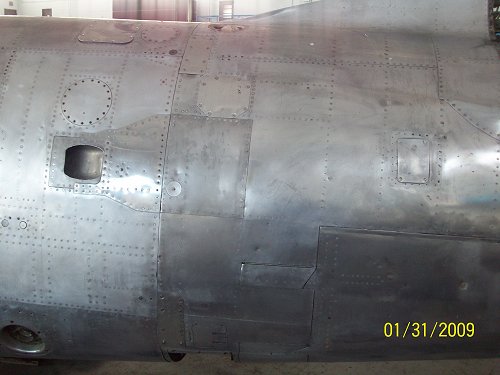
December
2008 Update
Since the last
instalment a considerable amount of work has been done on 53-658, centering
mainly on the repair of the numerous areas of skin damage. It would
have been tempting to bondo these areas and paint the aircraft silver.
But when finished, 53-658 will be one of a relatively few Sabres restored
in the historically-accurate natural metal finish.
By the end of November
2008, paint stripping of the fuselage was just about complete and polishing
of the wing leading-edge slats was continuing. In a few places the slats
were too badly damaged for just a quick polish, and these areas are
being replaced with new metal.
Above
left - One of the 'good' slat sections being polished and (right) -
Left-hand inboard slat skin section removed, ready for new skinning
(Ken Koehn).
Further, the nose
wheel has now been disassembled, with repairs to the tube ongoing. The
tires will be filled with foam upon completion. The nose wheel landing
gear strut is being cleaned of rust and will soon look good-as-new.
Above
MAPS volunteer hard at work on the nose gear.(Ken Koehn).
As mentioned above,
a great deal of work has been done on the external surface of the aircraft.
Below is just one example of the flight-standard repairs being carried
out, this time on the lower right-hand side of the forward fuselage.
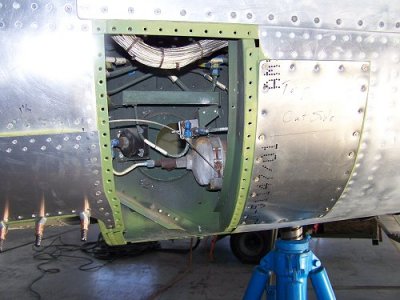 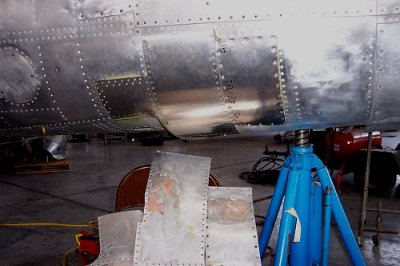
Above
- A series of 'before' - 'during' and 'after' shots of just one repair
area (Ken Koehn).
At some point in
its display life, numerous inspection panels had been lost from the
aircraft. As a 'quick fix' by persons unknown, these panels were skinned-over
with pop-rivetted sheet aluminium. Though this has undoubtedly stopped
a great deal of nesting birds from making the aircraft their home, it
does also mean that the MAPS crew has had to remove these patches and
new panels are gradually being made for the aircraft.
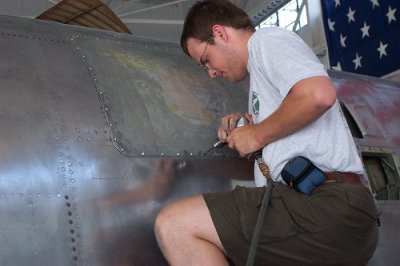 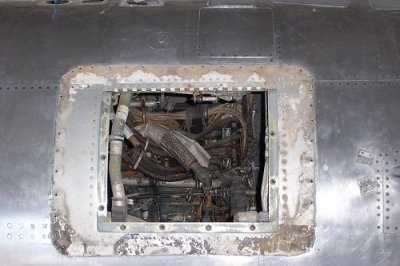
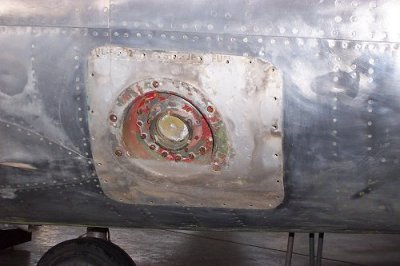
Above - Top:
'before' and 'after' shots of one of the patches being removed and
(right) the hole it covered. Bottom: another area that was patched
in the distant past - the single-point refuel receptacle. (Ken Koehn).
The aircraft's
radome - a prominent part of the aircraft - had been badly damaged and
repaired in the past. As a result it has already received a great deal
of attention to get it looking straight again. Now back to its correct
shape, it has been refitted to the aircraft and a preliminary coat of
paint applied.
Above
- 53-658 with its nose radome back in place after repairs (Ken Koehn).
Further detail
work has involved the numerous vortex generators - all damaged ones
have been fabricated and installed. The aircraft's horizontal stabilizer,
which had been cut in two, has been re-welded and sits on the aircraft
as one complete item once again. Finally a grant has been submitted
for acquisition of an ejection seat and missing instruments for the
cockpit. All in all, a busy year and one that has borne significant
results. 53-658 is slowly returning to her former glory.
June
2008 Update
Earlier this year
I was contacted by Kenneth Koehn, a key member of the MAPS F-86L restoration
team. To quote Ken,:
"Our intent is
to bring this aircraft back to its natural metal shine and yellow/black
markings of an F-86D of the 496th FIS out of Hahn AFB, Germany. We are
doing this to honor one of our museum and restoration team members,
Mac McFarland who worked on the F-86D at Hahn, and also Lt. Lang, who
was killed returning from an interceptor mission in Germany while flying
with this unit."
Above
- How 53-658 should look once restoration is finished - representing
F-86D s/n 52-4123 of 496th FIS.
Lt Lang was flying
F-86D s/n 52-4123 at the time of his accident and it is this aircraft
that will be represented by 53-658 once restoration is complete. And
though 53-658 is actually an F-86L (rather than the F-86D which it will
represent), it has one feature of the F-86D that many F-86Ls do not
have: being one of those early F-86L conversions (as detailed above),
this machine does not have the prominent 'sugar scoop' fuselage intakes
typical of most F-86Ls and F-86Ds late in service. Instead it has flush
NACA-type side intakes on the mid-fuselage and is thus accurate to portray
a 496th FIS F-86D of this period in that respect.
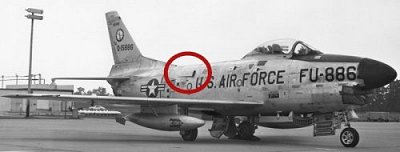
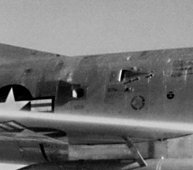
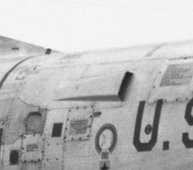
Above (left)
- the 'correct for F-86D' flush NACA side intake featured on 53-658
and (right) - the 'sugar scoop' version seen on most F-86Ls
Since its recovery
from Florida in 2007, the MAPS team has reassembled the aircraft and
managed to locate a number of missing items. The windshield frame has
been removed for restoration and with many of the access panels removed
it is possible to see that much of the internal equipment and wiring
is intact. Sadly the cockpit has been comprehensively stripped and attention
will be focussed on restoring this important area. The museum is committed
to restoring this aircraft in natural metal finish (essential for an
accurate colour scheme), and this will cause the team extra headaches
as the external structure has suffered over the years from poor handling.
Another item in
need of attention is the aircraft's nose radome, which has been damaged
in the past and badly repaired.
I will end this
instalment with an overall shot of 53-658 as she is today (June 2008):
Above
- 53-658 in the restoration hangar at Akron-Canton.
If you can
help MAPS with spare parts or assistance, email Ken Koehn at: KTMKOEHN
@aol.com
|
